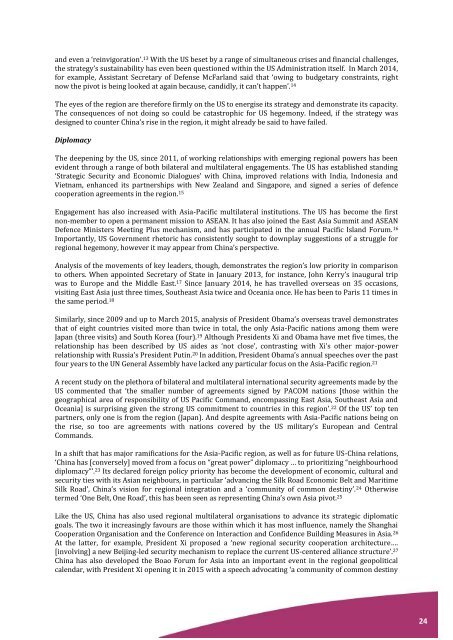Issue No 198 2015
198 2015 Nov_Dec
198 2015 Nov_Dec
You also want an ePaper? Increase the reach of your titles
YUMPU automatically turns print PDFs into web optimized ePapers that Google loves.
and even a ‘reinvigoration’. 13 With the US beset by a range of simultaneous crises and financial challenges,<br />
the strategy’s sustainability has even been questioned within the US Administration itself. In March 2014,<br />
for example, Assistant Secretary of Defense McFarland said that ‘owing to budgetary constraints, right<br />
now the pivot is being looked at again because, candidly, it can’t happen’. 14<br />
The eyes of the region are therefore firmly on the US to energise its strategy and demonstrate its capacity.<br />
The consequences of not doing so could be catastrophic for US hegemony. Indeed, if the strategy was<br />
designed to counter China’s rise in the region, it might already be said to have failed.<br />
Diplomacy<br />
The deepening by the US, since 2011, of working relationships with emerging regional powers has been<br />
evident through a range of both bilateral and multilateral engagements. The US has established standing<br />
‘Strategic Security and Economic Dialogues’ with China, improved relations with India, Indonesia and<br />
Vietnam, enhanced its partnerships with New Zealand and Singapore, and signed a series of defence<br />
cooperation agreements in the region. 15<br />
Engagement has also increased with Asia-Pacific multilateral institutions. The US has become the first<br />
non-member to open a permanent mission to ASEAN. It has also joined the East Asia Summit and ASEAN<br />
Defence Ministers Meeting Plus mechanism, and has participated in the annual Pacific Island Forum. 16<br />
Importantly, US Government rhetoric has consistently sought to downplay suggestions of a struggle for<br />
regional hegemony, however it may appear from China’s perspective.<br />
Analysis of the movements of key leaders, though, demonstrates the region’s low priority in comparison<br />
to others. When appointed Secretary of State in January 2013, for instance, John Kerry’s inaugural trip<br />
was to Europe and the Middle East. 17 Since January 2014, he has travelled overseas on 35 occasions,<br />
visiting East Asia just three times, Southeast Asia twice and Oceania once. He has been to Paris 11 times in<br />
the same period. 18<br />
Similarly, since 2009 and up to March <strong>2015</strong>, analysis of President Obama’s overseas travel demonstrates<br />
that of eight countries visited more than twice in total, the only Asia-Pacific nations among them were<br />
Japan (three visits) and South Korea (four). 19 Although Presidents Xi and Obama have met five times, the<br />
relationship has been described by US aides as ‘not close’, contrasting with Xi’s other major-power<br />
relationship with Russia’s President Putin. 20 In addition, President Obama’s annual speeches over the past<br />
four years to the UN General Assembly have lacked any particular focus on the Asia-Pacific region. 21<br />
A recent study on the plethora of bilateral and multilateral international security agreements made by the<br />
US commented that ‘the smaller number of agreements signed by PACOM nations [those within the<br />
geographical area of responsibility of US Pacific Command, encompassing East Asia, Southeast Asia and<br />
Oceania] is surprising given the strong US commitment to countries in this region’. 22 Of the US’ top ten<br />
partners, only one is from the region (Japan). And despite agreements with Asia-Pacific nations being on<br />
the rise, so too are agreements with nations covered by the US military’s European and Central<br />
Commands.<br />
In a shift that has major ramifications for the Asia-Pacific region, as well as for future US-China relations,<br />
‘China has [conversely] moved from a focus on “great power” diplomacy … to prioritizing “neighbourhood<br />
diplomacy”’. 23 Its declared foreign policy priority has become the development of economic, cultural and<br />
security ties with its Asian neighbours, in particular ‘advancing the Silk Road Economic Belt and Maritime<br />
Silk Road’, China’s vision for regional integration and a ‘community of common destiny’. 24 Otherwise<br />
termed ‘One Belt, One Road’, this has been seen as representing China’s own Asia pivot. 25<br />
Like the US, China has also used regional multilateral organisations to advance its strategic diplomatic<br />
goals. The two it increasingly favours are those within which it has most influence, namely the Shanghai<br />
Cooperation Organisation and the Conference on Interaction and Confidence Building Measures in Asia. 26<br />
At the latter, for example, President Xi proposed a ‘new regional security cooperation architecture….<br />
[involving] a new Beijing-led security mechanism to replace the current US-centered alliance structure’. 27<br />
China has also developed the Boao Forum for Asia into an important event in the regional geopolitical<br />
calendar, with President Xi opening it in <strong>2015</strong> with a speech advocating ‘a community of common destiny<br />
24


